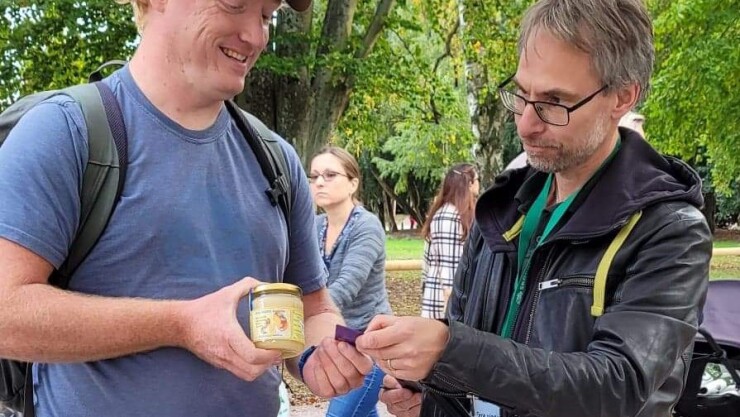For many merchants, the ability to attach a physical or Bluetooth card reader to a phone to accept payments was convenient — but not convenient enough.
"As I don't usually have a long line of customers waiting to pay, there are pauses between sales which are long enough for the card reader to enter sleep mode. Then I have to wait for the card reader to wake up and resume contact with my phone before the payment can go through," said Anton Lundqvist, who runs the Fyra Vindars Bigårdar (Four Winds Bee Farms) in Lund, Sweden.
Lundqvist, a customer of PayPal's Zettle, switched to tap-on-phone payments when it launched on Zettle's Android app this Spring. He produces and sells his own honey to customers at farmers' markets and to people placing orders by phone.
When companies like Square (now called Block) and PayPal introduced plug-in card readers roughly a decade ago, they opened up a new market for merchants that wanted to accept card payments but didn't want or need a traditional acquirer relationship or a stationary point-of-sale terminal; instead, those sellers could simply get a pocket-sized magstripe reader at a corner store or by mail. Around the same time, smartphone makers began adding Near Field Communication chips to their handsets to allow users to make — but not receive — contactless payments.
Lately that's changed, as Google and Apple have both made it possible for payment companies to accept contactless payments in their apps without any extra hardware.

"At farmers' markets I and the other seller on my stand can both accept payments using Tap to Pay at the same time. Tap to Pay is always on and there's no waiting," Lundqvist said. "Although the hardware-based card reader worked fine, it was one more thing to charge and bring with me, and it could run out of charge in the middle of the day."
Tap to Pay (Zettle's name for the service) is still new to most of Lundqvist's customers, so there has been a learning curve. Some joke about the phone skimming their card information, but most are simply surprised that tap-on-phone payments can be done, Lundqvist said.
Besides micromerchants, many established small and midsize enterprises (SMEs) have adopted Tap to Pay in addition to traditional POS hardware, according to Stefan Knorn, product manager at PayPal Zettle, which currently offers the software in the U.K., the Netherlands and Sweden. "SMEs with physical stores can use it in-store for line-busting during busy periods and also at farmer's markets or pop-up sites," he said. "Also, it can act as a backup if a merchant's card reader runs out of charge."
The fastest growth for tap-on-phone payments will be traditionally cash-heavy micro-merchants such as food stand operators or taxi drivers who have a growing need to adopt contactless payments for customers moving away from cash, said Jordan Rookes, a research analyst at Juniper Research.
The market for tap-on-phone payments is still emerging, according to Juniper. The number of contactless-enabled merchant smartphones using tap-on-phone technology in Europe will rise from 0.82 million in 2021 to 0.95 million in 2022 and 1.1 million in 2023, it predicts. This compares with lower figures in North America where the number of merchant smartphones using this technology will rise from 0.53 million in 2021 to 0.61 million in 2022 and 0.73 million in 2023. In Asia, where tap-on-phone is better established, the number of merchant smartphones using the technology will rise from 2.96 million in 2021 to 3.59 million in 2022 and 4.53 million in 2023, Juniper says.
The U.S. lagged Europe in adopting tap-on-phone payments because the technology was available only for Android-based phones and not for iPhones, which have a significantly higher market share among U.S. merchants, Rookes said.
But with Apple's June 2022 launch of
San Francisco-based payment service provider Stripe has been heavily promoting Tap to Pay on iPhone to its U.S. platform partners. Early adopters include Shopify, salon booking system GlossGenius, barber shop booking system Squire, and online activity booking provider FareHarbor.
"These platforms have launched the payment method to their collective millions of users," said David Yang, product manager at Stripe Terminal, in an email. "Thousands of Stripe businesses are using it every week in the U.S, and almost half of them have never used any card reader hardware before."
FareHarbor, which works with businesses in the tours, activities and attractions industries, has seen adoption of Tap to Pay on iPhone across the board, said Adi Pogolansky, Amsterdam, Netherlands-based FareHarbor's head of product, in an email.
"Many of our clients operate on the go, taking payments and checking in customers at boat docks and bus stops instead of at a desk or in an office," she said. "Some have pop-up locations around town in addition to a main office. So not having to rely on extra hardware and connecting devices to card readers has been a major benefit."
According to feedback from FareHarbor's clients, it is easier to train new staff to use Tap to Pay on iPhone than it is to train them for other payment methods, Pogolansky said. "Some companies found Tap to Pay so efficient that they have switched to a cashless payment model," she said.
CabCard Services, a U.K.-based payment facilitator serving mostly taxi companies, uses the SoftPOS system from U.K.-based payment technology developer
"SoftPOS can be deployed very quickly with no upfront investment in dedicated payment hardware," said CabCard's chief technology officer Chris Jamieson. "This is an important consideration for our primary customer base of taxi fleets and their drivers. New customers can land on our website, complete our online onboarding process, download, and set up the SoftPOS solution and start taking payments within about 15 minutes. So a fleet of 100-500 taxi drivers can be equipped with in-vehicle card payment acceptance facilities in hours rather than weeks, with no need to purchase and install dedicated hardware."






